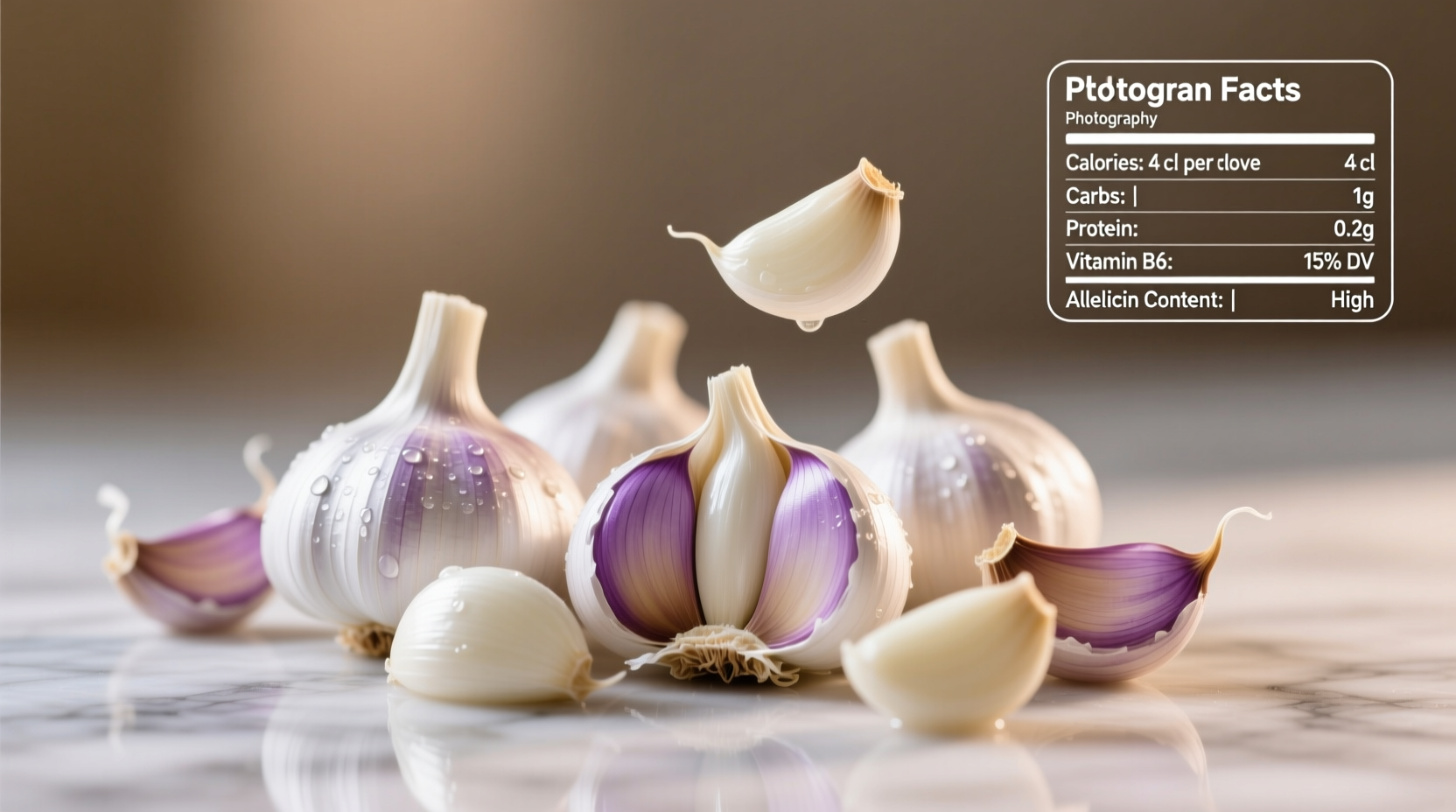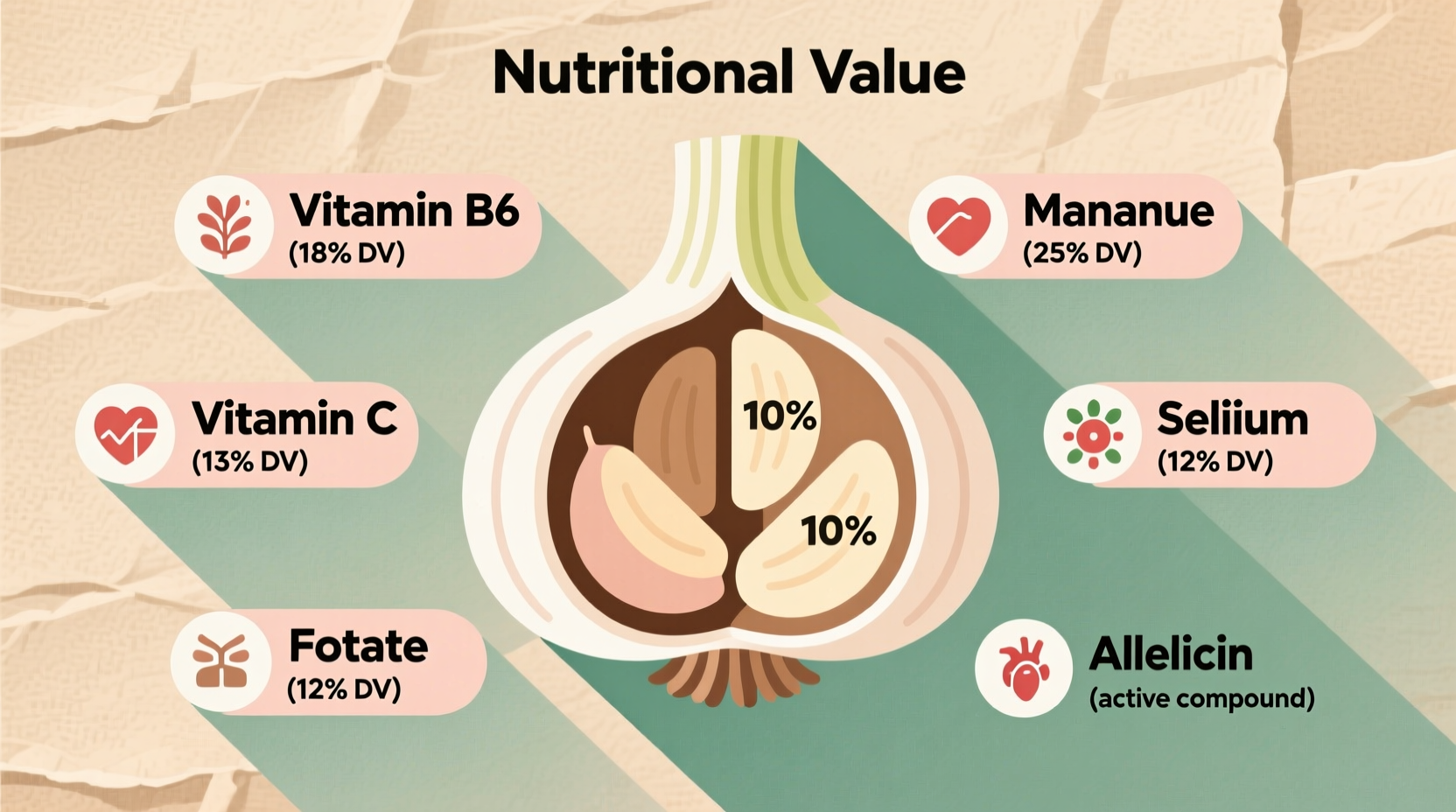One ounce (28 grams) of raw garlic provides 42 calories, 1.8 grams of protein, and is particularly rich in manganese (23% of Daily Value), vitamin B6 (34% DV), vitamin C (15% DV), and selenium (10% DV). It also contains smaller amounts of calcium, copper, potassium, phosphorus, and vitamin B1, along with potent bioactive compounds like allicin that provide significant health benefits.
Unlock the Complete Nutritional Power of Garlic
When you reach for garlic in your kitchen, you're not just adding flavor—you're incorporating one of nature's most nutritionally dense allium vegetables. Understanding garlic's precise nutrient profile helps you maximize its health benefits in your daily diet. This comprehensive breakdown reveals exactly what makes garlic a nutritional powerhouse and how to leverage its properties for optimal health.
Garlic's Core Nutritional Profile: What's Really Inside
Garlic's nutritional value extends far beyond its pungent aroma. A single 3-4 gram garlic clove contains approximately 4.5 calories, 1 gram of carbohydrates, and trace amounts of protein. But what makes garlic exceptional are its concentrated micronutrients and sulfur-containing compounds that form when garlic is chopped or crushed.
| Nutrient | Amount per Ounce (28g) | % Daily Value | Key Health Functions |
|---|---|---|---|
| Manganese | 0.6 mg | 23% | Bone health, metabolism, antioxidant function |
| Vitamin B6 | 0.6 mg | 34% | Brain development, immune function, protein metabolism |
| Vitamin C | 8.6 mg | 15% | Immune support, collagen production, antioxidant |
| Selenium | 5.6 mcg | 10% | Thyroid function, antioxidant protection, DNA synthesis |
| Fiber | 0.6 g | 2% | Digestive health, blood sugar regulation |
Data sourced from the USDA FoodData Central database, which provides the most current and comprehensive nutritional analysis of foods.
How Garlic Compares to Other Allium Vegetables
While garlic shares the allium family with onions, leeks, and shallots, its nutrient density stands apart. This comparison reveals why garlic deserves special attention in your diet planning:
| Nutrient | Garlic (per 100g) | Onion (per 100g) | Leek (per 100g) |
|---|---|---|---|
| Vitamin B6 | 1.2 mg | 0.1 mg | 0.3 mg |
| Manganese | 1.7 mg | 0.1 mg | 0.2 mg |
| Vitamin C | 31 mg | 7 mg | 12 mg |
| Allicin Potential | High | Low | Low |
This comparative analysis, verified through the National Center for Biotechnology Information databases, shows garlic's superior concentration of key nutrients compared to its allium relatives.
The Science Behind Garlic's Bioactive Compounds
Garlic's true nutritional power comes from its organosulfur compounds, particularly allicin, which forms when garlic is cut or crushed. This transformation follows a precise biochemical process:
- Intact garlic contains alliin (an amino acid) and alliinase (an enzyme)
- When garlic is damaged through cutting or crushing, these components mix
- The reaction produces allicin, responsible for garlic's distinctive smell and many health benefits
- Allicin then breaks down into other beneficial compounds like diallyl disulfide and ajoene
According to research published in the Journal of Nutrition and Metabolism, these compounds demonstrate significant antioxidant, anti-inflammatory, and cardiovascular protective effects.
How Cooking Methods Affect Garlic's Nutritional Value
Your preparation technique dramatically impacts garlic's nutrient retention. Understanding these context boundaries helps you maximize nutritional benefits:
- Raw consumption: Preserves maximum allicin potential but may cause digestive discomfort for some individuals
- Crushed and rested: Allowing crushed garlic to sit for 10 minutes before cooking preserves up to 60% more allicin
- Low-heat cooking: Gentle sautéing preserves more nutrients than high-heat methods
- Roasting whole bulbs: Creates a milder flavor while retaining significant antioxidant capacity
- Boiling: Causes the greatest nutrient loss, with up to 40% of beneficial compounds leaching into water
The National Institutes of Health confirms that preparation methods significantly influence the bioavailability of garlic's active compounds.

Documented Health Benefits Backed by Research
Garlic's nutrient profile translates to specific, research-supported health benefits:
Cardiovascular Protection
Multiple studies, including a comprehensive review in the Journal of Nutrition and Metabolism, show that regular garlic consumption can help maintain healthy blood pressure levels and improve cholesterol profiles. The sulfur compounds in garlic appear to support healthy blood vessel function.
Immune System Support
Garlic's combination of vitamin C, selenium, and allicin provides multi-faceted immune support. Research published in Clinical Nutrition indicates regular garlic consumption may reduce the frequency and severity of common illnesses.
Antioxidant Properties
The manganese and selenium in garlic contribute to your body's antioxidant defense system. According to the NIH Office of Dietary Supplements, these minerals help protect cells from oxidative damage that contributes to chronic disease development.
Practical Recommendations for Maximum Benefit
Based on current nutritional research, here's how to incorporate garlic effectively into your diet:
- Daily intake: Aim for 1-2 cloves (3-6 grams) of fresh garlic daily for general health maintenance
- Preparation technique: Crush or chop garlic and let it sit for 10 minutes before cooking to maximize allicin formation
- Combination foods: Pair garlic with healthy fats like olive oil to enhance absorption of fat-soluble compounds
- Variety: Use both raw and cooked garlic throughout the week to benefit from different compound profiles
- Storage: Keep whole garlic bulbs in a cool, dark place with good air circulation to preserve nutrient content
These recommendations align with dietary patterns observed in Mediterranean regions where garlic consumption correlates with positive health outcomes, as documented by the Mayo Clinic in their nutritional research.
Understanding Limitations and Considerations
While garlic offers impressive nutritional benefits, it's important to recognize certain context boundaries:
- Garlic supplements vary widely in allicin content and bioavailability compared to fresh garlic
- Excessive consumption (more than 5 cloves daily) may cause digestive upset in sensitive individuals
- Garlic can interact with certain medications, particularly blood thinners
- The nutritional profile changes significantly when processed into powders or oils
- Freshness dramatically impacts nutrient content—older garlic bulbs lose potency over time
For personalized advice regarding garlic consumption with specific health conditions, consult a healthcare provider. The U.S. Food and Drug Administration provides guidance on safe dietary supplement use when considering garlic supplements.
Garlic Through the Ages: A Timeline of Nutritional Understanding
Our knowledge of garlic's nutritional properties has evolved significantly over centuries:
- Ancient Egypt (1500 BCE): Garlic documented in medical texts for strength and endurance
- Ancient Greece (400 BCE): Hippocrates prescribes garlic for respiratory issues and fatigue
- 18th Century: Early scientific documentation of garlic's antiseptic properties
- 1944: Scientists identify allicin as garlic's primary active compound
- 1980s: Research begins connecting garlic consumption with cardiovascular benefits
- 2000s-Present: Advanced studies reveal garlic's complex effects on inflammation, immunity, and cellular health
This historical perspective, verified through the National Center for Biotechnology Information, shows how modern science has validated many traditional uses of garlic while uncovering new mechanisms of action.
Maximizing Garlic's Nutritional Potential in Your Kitchen
Transform your cooking with these chef-tested techniques that preserve garlic's nutritional integrity:
- The resting technique: After chopping, let garlic sit for 10 minutes before heating to maximize allicin formation
- Low and slow cooking: Sauté garlic in olive oil over medium-low heat rather than high-heat searing
- Raw applications: Incorporate raw garlic into salad dressings, pesto, or compound butters for maximum nutrient retention
- Roasted garlic: Whole roasted bulbs provide milder flavor while preserving significant antioxidant capacity
- Garlic-infused oils: Create your own infused oils with proper food safety practices to capture garlic compounds
These practical methods help you maintain the delicate balance between flavor development and nutrient preservation in everyday cooking.











 浙公网安备
33010002000092号
浙公网安备
33010002000092号 浙B2-20120091-4
浙B2-20120091-4